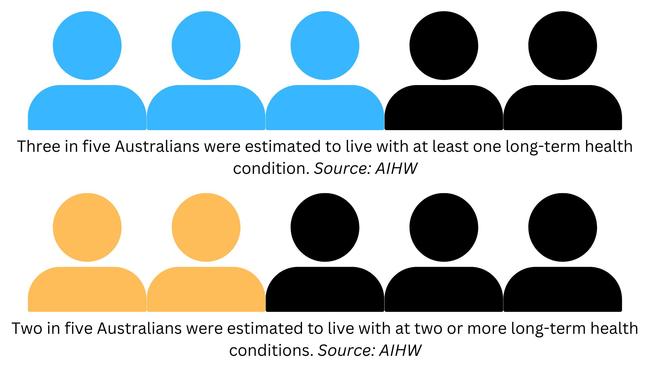How healthy is Australia really? New report card reveals health of the nation
Life expectancy in Australia decreased in 2020-2022, a new report has found. See why, and how long the average Australian can expect to live.

News
Don't miss out on the headlines from News. Followed categories will be added to My News.
Life expectancy has decreased for the first time since the mid-1990s, a new report by the Australian Institute of Health and Welfare (AIHW) has revealed.
According to the biennial report, life expectancy in Australia decreased by 0.1 years for males and females from 2019–2021 to 2020–2022.
This is likely due to the increase in deaths seen in 2022, of which close to half were due to Covid-19, the report states.
For the first time in 50 years, an infectious disease was in the top five causes of death in Australia, with Covid the third leading cause of death in 2022, behind coronary heart disease and dementia.
Despite the slight decrease in 2020-2022, life expectancy was still higher than it was in 2017–2019 by 0.3 years for males and females.
Further, Australia still has one of the world’s leading life expectancies at birth, sitting fourth highest among 38 OECD countries, after Japan, Korea and Switzerland.
A boy and girl born in Australia in 2020-2022 can expect to live on average to 81.2 years for males and 85.3 years for females.
AIHW deputy CEO Matthew James said the report offered an opportunity to reflect on Australia’s overall health.
“The last time we released an ‘Australia’s health’ report, it was mid-2022 and Australia was in the middle of the Omicron wave of the pandemic.
“Now, in mid-2024, it’s a good time to look back over the last few years and consider where we stand.
“‘Australia’s health 2024’ does just this, considering where Australia’s health and health system stand now, and what ongoing and future health challenges remain for us as a nation,” he said.
Australia’s ageing population
As Australia’s life expectancy has increased over time, so too have the number of years, on average, males and females spend in both full health and ill-health.
Between 2003 and 2023, males gained a total of 2.2 years in full health (from 69.4 to 71.6 years) and females gained a total 0.8 years in full health (from 72.8 to 73.6 years).
In the same period, the number of years males spend in ill-health has increased from 8.7 to 9.7 years, while the number of years females spend in ill-health has gone up from 10.2 to 11.5 years.
The report also highlights how with greater life expectancy comes a greater burden of chronic conditions on the Australian population.
About three in five Australians were estimated to live with at least one long-term health condition, and two in five with two or more such conditions, in 2022.

Chronic conditions contributed to between 89 and 92 per cent of all deaths each year in Australia from 2002-2022.
“Chronic conditions present a key challenge for individuals, governments and society as a whole,” Mr James said.
“For example, with an ageing and growing population, AIHW predicts that the number of Australians with dementia will more than double by 2058 to 849,300 – 533,800 women and 315,500 men,” he said.
Cancer continues to be a major cause of illness in Australia, with the report finding that on average, more than 450 cases were diagnosed each day in 2023.
Consistent with Australia’s population, between 2000 and 2023, the number of new cancer cases increased by 88 per cent and deaths from cancer increased by 41 per cent.
When adjusted for age, however, the rate at which new cancer cases were diagnosed increased by 8 per cent, while the rate at which people died due to cancer decreased by 25 per cent.
From 2000 to 2023, the cancer death rate fell for all 10-year age groups up to the age of 84.
“Seven in 10 people survived at least five years after a cancer diagnosis during 2015–2019, an improvement from five in 10 in 1990–1994,” Mr James said.
“Since the National Cervical Screening Program was introduced in 1991, the age-standardised death rate for cervical cancer has halved,” he added.
Young Australians
While Australia’s ageing citizens grapple with chronic health conditions, many young Australians are dealing with the burden of mental health issues.
While the overall proportion of people with a mental disorder in the past 12 months was similar in 2007, there was a notable increase among young people.
In 2020–2022, 39 per cent of 16-24-year-olds had a mental illness in the past 12 months.

The last time a comparable measure was collected in 2007, it was 26 per cent.
This change is almost entirely driven by an increased prevalence among females in this age group (46 per cent in 2020–2022 – up from 30 per cent in 2007), the report states. This was the highest rate for females, and higher than for males of any age.
Overall, an estimated 8.5 million Australians (43 per cent of the population) aged 16-85 had experienced a mental disorder at some time in their life while 4.3 million people aged 16-85 (22 per cent of the population) had experienced a mental disorder in the last 12 months.
Risky health behaviours
“Australia’s health 2024” reveals a decline in some risky health behaviours but an increase in others.
Smoking tobacco – which causes more deaths than any other behavioural risk factor – continues to drop, while vaping has become more common.
8.3 per cent of people aged 14 and over smoked tobacco daily in 2022–2023, compared with 12.2 per cent in 2016.
Meanwhile, in 2022–2023, for people aged 14 and over, 3.5 per cent were using e-cigarettes daily – up from 0.5 per cent in 2016.

Mr James said young people were the group most likely to vape everyday.
“People aged 18–24 were the age group most likely to use e-cigarettes daily (9.3 per cent) in 2022–2023,” Mr James said.
“For the same year and age group, 5.9 per cent smoke tobacco daily.
“In 2022–2023, females aged 18-24 were more likely to use e-cigarettes daily compared with males – 10.3 per cent of females and 8.5 per cent of males,” he said.
When it comes to alcohol consumption, the report found that less people aged 14 and over are drinking alcohol in ways that put their health at risk.
The report found that risky alcohol consumption has fallen from 39 per cent in 2004 to 31 per cent in 2022–23.
Additionally, more Aussies are meeting exercise recommendations, Mr James said.
“More people are physically active, with fewer not meeting physical activity guidelines compared with five years ago,’ Mr James said.
“37 per cent of adults aged 18–64 did not meet the physical activity guideline in 2022, a decrease from 51 per cent in 2017–18.”
The report card of Australia’s health was launched today by the Minister for Health and Aged Care, Mark Butler.
Originally published as How healthy is Australia really? New report card reveals health of the nation



